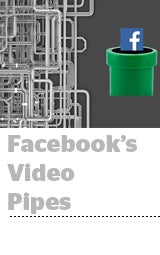 In a significant expansion of its video ad offering, Facebook will bring video ad formats to its Instant Articles platform and to the external apps and sites in its Audience Network, the company announced Monday.
In a significant expansion of its video ad offering, Facebook will bring video ad formats to its Instant Articles platform and to the external apps and sites in its Audience Network, the company announced Monday.
It’s the first time the company will deliver video ads beyond its owned-and-operated properties – excluding its LiveRail video sell-side platform, largely discontinued.
Video brand ads are available via the Audience Network and can be purchased on a cost-per-view (CPV) model, where a view is 10 seconds, as well as a traditional CPM model, according to Facebook’s ad tech lead, David Jakubowski.
The video ads come in two formats: in-stream, which are ads that play during or after video content, and in-article, which are muted video ads embedded in articles that autoplay when half the pixels are in view.
Industry insiders believe the addition of branded video units could substantially expand available video inventory, though Facebook has been sparse on details about the service.
For instance, digital video is a hotbed for fraud and it’s unclear how Facebook will combat it on its platform, said Frank Sinton, CEO and co-founder of the video advertising firm Beachfront Media. It already has phased out the parts of its LiveRail SSP focused on the open web, though now Facebook is serving video beyond its owned-and-operated properties.
Sinton also was confused about the mixed messages Facebook is sending about pre-roll.
“Now I can buy pre-roll from Facebook, even though they’ve taken the stance that it’s interruptive and they won’t support it?” he said.
Moreover, Sinton wondered if the buying process will be transparent enough for advertisers, who must rely on Facebook to find their audience across other sites and apps but won’t have reporting or control over where the ads get served. Mashable, Daily Mail and USA Today Sports are pilot publishers for the product, but advertisers won’t know which sites displayed their ad, or in what video format.
Facebook’s flattening effect on prices and formats also “limits publishers’ ability to unlock the premium associated with their brand and the context of ad placement,” said Scott Braley, GM of advertising of the online video platform Ooyala.
On the other hand, outside of direct buys, advertisers typically are targeting audiences, and not contextual publisher content. As Braley also noted, “If most of a publisher’s value is derived from audience data, and they’re willing – or need – to outsource their buyer relationships, then I can see this being a strong solution for Facebook.”
Sarah Sluis contributed reporting to this article.












